Resources
The Simulation Center is a state-of-the-art teaching facility with 19 high fidelity human patient simulators and six medical rooms that can serve as an emergency room, intensive care unit, or regular hospital room.
The environment is created to be as real as possible.
Also located in Simulation Center are clinical examination rooms. Students from the
School of Medicine & Health Sciences use the area regularly for training and assessment
activities. Along with simulators and exam rooms, we also have a real ambulance called
the 'simbulance'.
SimBaby is an advanced infant patient simulator for team training. She has realistic anatomy and clinical functionality. SimBaby allows learners to practice and perfect their infant skills in a risk-free environment. SimBaby has:
- Realistic airway and allows training for all aspects of infant airway management
- Capability to replicate tongue edema, pharyngeal swelling, and laryngospasm.
- Spontaneous breathing patterns and complications
- Peripheral and intraosseous IV therapy
- Capability of becoming cyanotic
- Normal and abnormal cardiac rhythms and the capability for live defibrillation
- Change in findings of fontanel

SimMan 3G is a portable advanced patient simulator that provides for flexibility in simulation-based education. SimMan has a realistic anatomy and computer technology that mimics usual human physiological responses. SimMan 3G has:
- Multiple airway features and skill training
- Airway and breathing features, as well as complications
- Cardiac and circulation features
- Vascular Access
- Real-time CPR
- Responsive to pharmacology treatments
- Pupillary response
- Bowel sounds
- Multiple secretion sites (urine, sweat, nasal, CSF, etc.)
- Seizure capability
- Automatic or manual vital signs
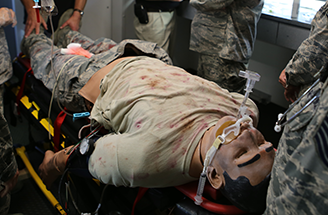
METIman is a Prehospital training human patient simulator. They are built tough to withstand a wide variety of real-life, indoor and outdoor learning environments. He has capabilities for:
- Airway management and complication
- Bilateral pulses
- Cardiac and respiratory normal and abnormal
- Bowel sounds normal and abnormal
- Full articulation of extremities and neck
- Changeable external genitalia with urinary output
- Reactive pupils
- Multiple IV cannulation sites
- Chest tube placement and needle decompression
- Ability for realistic trauma and wounds with bleeding
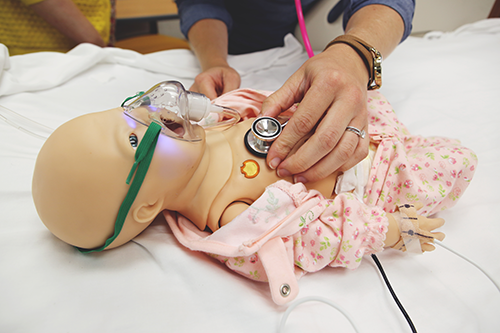
Hal is a fully wireless infant simulator that responds to physiologic modeling and trending. He includes normal and abnormal cardiac and respiratory features. His color and vital signs are responsive to hypoxic events and interventions. Hal gives learners the ability to apply their skills in a real-time, risk-free environment. He can be used for:
- APGAR scoring.
- IV training
- Oral and nasal intubation
- Umbilical pulse
- Pulses
- Crying and convulsions
- Inter-changeable genitalia
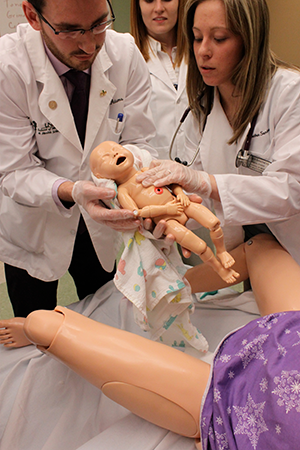 Noelle is designed to provide a complete birthing experience before, during, and after
delivery. Noelle has:
Noelle is designed to provide a complete birthing experience before, during, and after
delivery. Noelle has:
- Normal and abnormal heart sounds
- Normal and abnormal breathing
- CPR responsive
- Normal and abnormal childbirth
- Postpartum hemorrhage
- Episiotomy trainer
- Cesarean section trainer
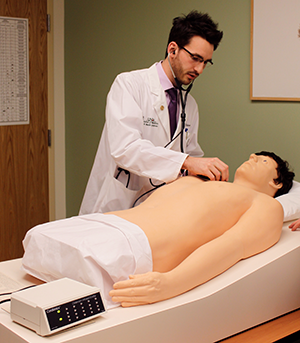
Harvey is a proven simulation system to teach bedside cardiac assessment skills that transfer to real patients. The cardiopulmonary simulator features:
- Blood pressures, pulses, heart sounds and cardiac murmurs
- Six breath sound areas
- Nine cardiac auscultation areas
- 30 cardiac diseases
- Twelve impulse areas
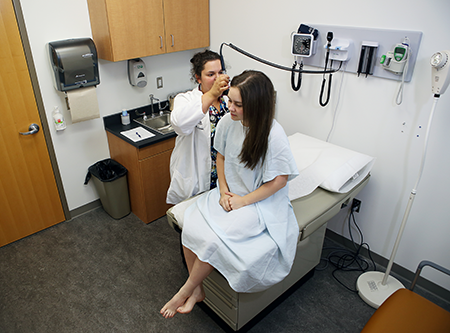
There are 14 examination/interview rooms with one-way windows. Technology in the exam room area allows for the audio-visual recording of student and patient encounters.
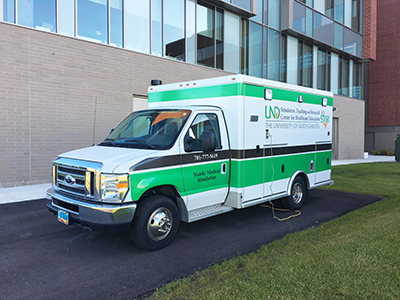
The "simbulance" environment can be simulated to take the patient to surgery and into intensive care. The simulated event is recorded for playback and evaluation following the event, when memories and emotions are fresh. The event provides hands on learning for students and professionals that reinforce patient safety.